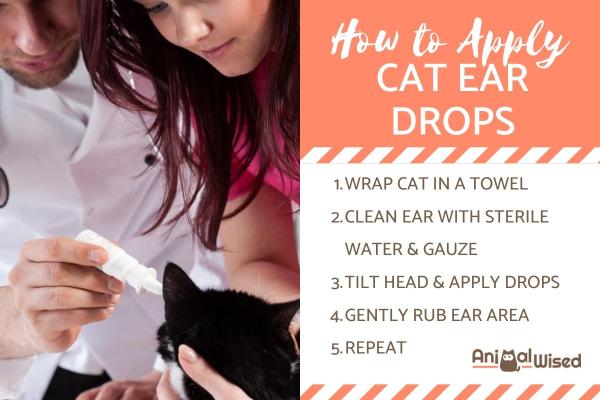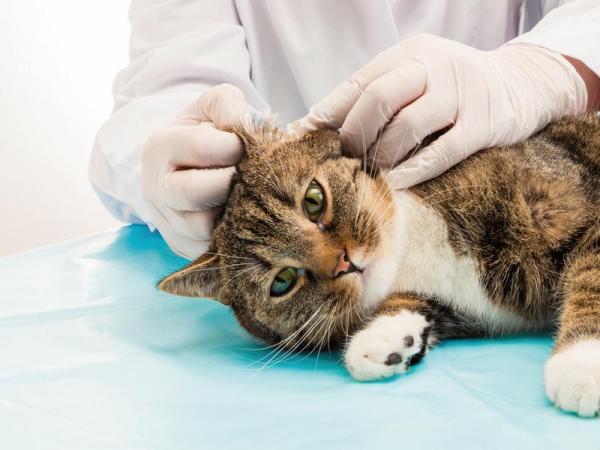How to Apply Cat Ear Drops



See files for Cats
Cats are relatively prone to ear infections, especially long-eared cat breeds. Mites, otitis and other ear problems can be bothersome, but they are usually easily treatable. As long as we are observant of their symptoms and treat them in time, prognosis is generally very good. However, treating a cat's ear infection is not always the easiest. Since a cat may already be irritable from having a sore ear, applying ear drops may not be as easy as it should be. In some extreme cases, we may need to take the cat to the veterinarian to have them applied professionally.
At AnimalWised, we show you everything you need to know about how to apply cat ear drops. We let you know a little about cat ear medicine and how we can keep the animal relaxed to make it as easy as possible.
Symptoms of ear problems in cats
As we stated above, ear trouble can be very annoying for a cat. It is one of the most obvious problems, even if the causes can be varied. If your cat has any of the following symptoms, you should take it to the vet since they probably need to be prescribed ear medicine:
- Ears are red and inflamed (otitis)
- Ears feel warm to the touch
- Excess ear wax buildup
- Oozing pus and or foul odor
- Tilting of the head
- Repeatedly scratching their ears
- Black spots in and around the ears
While it may be obvious there is a problem, we will need to take the cat to a veterinarian to properly diagnose the problem. Many issues need specific ear drops to be prescribed.

Causes of ear problems in cats
While there will be many shared symptoms, the causes of ear problems in cats stem from different issues. Also, ear problems can affect the outer ear, the inner ear or both. They include:
- Ear wax build up/not cleaning ears
- Mites
- Presence of foreign objects
- Bacterial/viral infections
- Ruptured ear drum from loud noise/trauma
- Chemical irritant entering ear canal
- Autoimmune diseases
- Tumors
As you can see, most of the causes of ear problems in cats are relatively treatable. Bacterial and viral infections can usually be treated, but early diagnosis is important. For autoimmune diseases, ear infections are one of many possible complications relating to a compromised immune systems. Tumors of the ear are relatively rare in cats and you will like see a concurrent neoplastic growth.
Treatment will depend on the cause. If the otitis is caused by a foreign object, removal of the object may be sufficient. However, they may require antibiotic treatment if there is the presence of a secondary infection. Bacterial and viral infections will be treated with drugs specific to the underlying pathogen. For autoimmune diseases, drugs may be helpful to help bolster their immune system, but a larger systematic treatment will be required.
Drugs can be administered orally, but most ear problems in cats will be treated with ear drops containing the active ingredient to treat the problem.
Materials to apply cat ear drops
Once the veterinarian has diagnosed the ear problem in your cat and prescribed the correct medication, you will need to prepare for applying the ear drops. To avoid any incidents, you will need to have the following material at hand:
- A large towel
- Sterile gauze pads
- The specific drops
When you have everything ready, you will need to find the cat. Ideally you should wait until the cat is calm and relaxed. Even better, you may be able to apply them when the cat is sleeping if the ear is exposed. If not, when the cat comes to look for you for attention, this means they may be more receptive to interaction. Before applying the cat's ear drops, pet them and help them to relax. Don't catch them by surprise or they will be scared and it may hurt your bond.
If you have someone else there to help hold the cat, this may be preferable. If not, you can wrap them in a blanket or large towel. Swaddle them like a burrito and hold them tight. However, do not go overboard and cause harm by restricting their breathing. Take them to a suitable place to apply the drops. Wrapping them is important if you have a cat which is prone to scratching or biting.

How to apply cat ear drops
With the cat bundled in the blanket or in the towel we can put the drops on it without danger of them escaping or trying to scratch us. The step-by-step process is the following:
- Clean the cat's ears first by removing any excess ear wax or pus that may be found. This is important as otherwise it can hinder the transit of the drops into the ear canal. You can buy special feline ear cleaners for this purpose. Apply it to the sterile gauze and wipe the outside of the ear. Do not enter the ear or you might hurt the ear drum. If you do not have ear cleaning solution, clean water and the gauze may be sufficient.
- When the ears are clean, tilt the cat's head to one side and apply the amount of drops recommended by the veterinarian. When you have applied the amount required, gently rub the outside of the ear to help the drops enter the ear canal properly.
- When the drops have been administered, do the same to the other ear (when necessary).
If you follow the treatment as the veterinarian has recommended, the problem should relieve itself. However, if you do not complete the course of treatment, it has greater chances of returning. This is important even if the ear looks like it has healed. Take the cat back tot he veterinarian if the problem does not relieve after the correct treatment.
To know more, you can take a look at our video on why your cat's ears feel hot:

This article is purely informative. AnimalWised does not have the authority to prescribe any veterinary treatment or create a diagnosis. We invite you to take your pet to the veterinarian if they are suffering from any condition or pain.
If you want to read similar articles to How to Apply Cat Ear Drops, we recommend you visit our Other health problems category.








